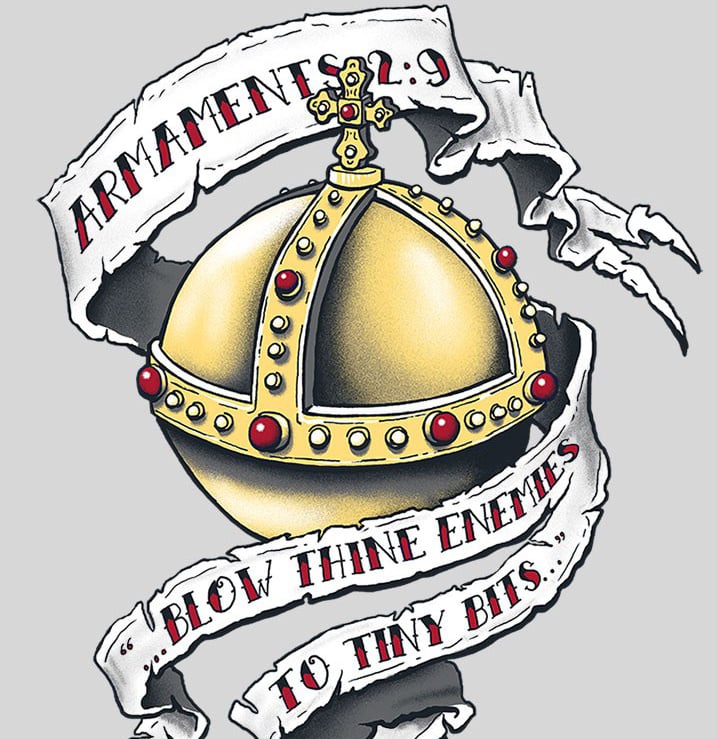I have this theory that Americans suck at math because they insist on sticking with the imperial measurement system and so nothing makes mathematical sense - Americans intuitively just think in every day units qualitatively. Whereas the rest of the world uses metric, so base 10 math just comes naturally.
Source: I am a US STEM professor. Our students suck at math.
When I was 16, I went to high school in California for half a year as an exchange student. I am from Germany and as a junior, I would have had something like my 4th or 5th year of chemistry in school, but out of necessity (or laziness) I took beginner’s chemistry.
For exercises I had been paired with two girls who used to try to make fun of me (I think; I never really figured out what their deal was), and asked me stupid questions about myself or Germany. I remember they once asked laughingly whether I like oranges because I was wearing a t-shirt with an orange print.
Well, then one day, there we go. Converting exercises. You have students from 9th to 12th grade in groups of 3-4, trying to convert imperial measurements to metrics. And then metrics to metrics. Basically, for a couple of weeks, we just converted stuff like 14 cm to mm or dm. I forgot so much about my time abroad but the most vivid memory I have is of the girls looking at each other (after a couple of days and repeated explanations) and one says “the decimal system just makes no sense” and the other one quietly and slowly nods in agreement. I ask them how it makes no sense. “Well it just makes no sense.” It’s just base 10 everything and the rest is practice, it’s not different from inches to feet. “No but you see this makes sense. There are 12 inches in a foot”, continued by a list of how many shmekels make up a whoopsiedoodle and how many dingelings fit into a hybotron.
I understand how you first have to get accustomed to new units and how conversion might need practice when you aren’t familiar with the prefixes, especially when you aren’t too experienced in the stem field. But I am still flabbergasted by the statement that having a system where everything is just base 10 and then you shift the decimal point around makes no sense. We are talking about fellow juniors here. How do you make it to age 16/17 never having heard of a decimal point or having trouble with base 10 conversion? HOW CAN YOU SAY IT MAKES NO SENSE?! It’s the simplest, most logic based system there is!
IMO metric also allows you to reason about things in your head more easily because doing base-10 calculations in your head is doable.
For example, “Each 1m section of a pipeline contains 20L of oil. The goal is to empty a 200 km section of pipe into trucks. If each truck can handle 20 tonnes of oil, how many trucks would be needed?” In metric that calculation is 20 * 1000 * 200 = 4 million L. 20 tonnes is approx 20,000 L since 1L of water is 1kg, so it’s going to be at least within an order of magnitude of that for oil. 4M / 20k = 200.
With US customary units it would be "Each 1 foot section of a pipeline contains 1.5 gallons of oil. The goal is to empty a 100 mile section of pipe into trucks. If each can handle 20 tons of oil, how many trucks will be needed? To handle that calculation you’ll have to convert feet to miles. Gallons to pounds, pounds to tons, etc. You can do it on paper, but all those weird conversions add massively to the difficulty.
There’s a reason why the American science community has long converted to metric. You just can’t do calculations like this quickly enough.
well how dense is the oil
Not as dense as those teenagers
True, also i side note. Tanker turks are measured in Volume here. Thats makes it easier
I’m imagining a tank wearing a fez.
tanker trucks
Crude is approximately the same as water, about 0.8 to 0.9 g/mL. But, even if it were significantly less dense, like gasoline (0.74 g/mL) it’s still good for an order-of-magnitude calculation. Knowing that 1L has a mass of 1kg is especially useful since many of the liquids we commonly encounter are water-based.
.8 to .9 for crude (where water is 1)
Fuck me we did those conversions in primary school in Italy in the eighties. Can’t remember what year exactly but we were prolly 7yo?
Exactly, we also had this early on. Also with imperial measurements or some random antique ones. I remember the worst conversion exercises were in grade 5, where you had to convert a large number, say 5316, to a number if the base was 8, not 10. This felt completely useless and took a lot of time but it also wasn’t necessarily hard. And it made sense because math usually does.
ok how about this america abopts the metric system but every moves on to base 12.
Fifth grade prepared me for base whatever, bring it on
Ok in base pi what is 10
Oh that’s a great question, we only did integers as bases - my guess would be 100.58 (or 100.18)? But I absolutely admit defeat here.
Non-integer base, anyone?
2i is also fun
It may be that or it may be that our entire educational system has turned into shit through decades of low pay for teachers weeding out all the best people.
I am a US STEM professor.
Prove it! What is the speed of light in anacondas/average Snapchat duration?
Edit: around 10^11 anacondas per average daily snapchat usage among US teens
Does the person on Snapchat have buns? 'Cause otherwise my anaconda don’t want none, hun.
Isn’t there a filter for that?
2! No, 3!
deleted by creator
I have a theory that Americans are great at math because they regularly work with base-12 systems.
That would be cool if true. But then they use measures like subdivisions of an inch in base 8 increments.
It’s closer to a binary system, since it’s iterative division by two. Half inch, quarter, eighth, sixteenth and so on.
People do the same thing in metric, but they just prefer to write 0.125 cm instead of 1/8 cm.
Imperial units are a bit more heavy on rational numbers instead of decimal.
The base 12 stuff comes up with things that were historically cut in halves as well as thirds.
It’s all highly composite numbers, since they’re easier to work with if you’re doing repeated division in your head. Ten is only divisible by 2 and 5 before you start to get a lot of rapidly growing decimal parts. 12 is divisible by 2,3,4,6.
If you’ve got a balance, a knife and a stone we all agree on the weight of (let’s call it a pound stone), it’s easy to measure our a half or third of a pound, and halves or thirds of any other portion I can produce.
Over time, common divisions got names and a system of units was produced that was entirely inconsistent but liked 12 and 60 because of ease of use, and powers of two because you can just keep cutting them in half.It’s all moot since we can use a scale now instead of a balance with a rock, and we can trust measuring tapes instead of repeatedly bisecting a plank, but it at least gives context to why it prefers fractions and numbers like 12 and 8.
And base 3 sometimes (yards). When taught well, there’s a ton of value in learning to quantify the world in a variety of base systems.
Not uniquely American, but thinking in base 7 (weeks), base 12 (years, hours, feet), base 60 (minutes), base 3 (yards), base 10 (the default unless told otherwise), etc. really helps you adapt and estimate a number of other, unrelated, things.
My professor for my first real engineering class had an excellent quote, “A good engineer can work in any unit system.”
There’s actually quite a lot of advantages the US could have in math education if we properly harnessed both unit systems. Becoming fluent in both and regularly doing conversions would give students a lot of real world application and simple math practice.
A good software developer can also work with any language, but if you’re going to use Javascript to build an enterprise level software you are guaranteed to have a bad time.
You use what is best for the job and from my understanding there’s really no benefit to using imperial measures over SI, beyond the familiarity of growing up with them. If you were taught SI units from the very start you wouldn’t ever use imperial.
There are actually reasons to use imperial, but it’s all inertia. Industry has a bunch of controls and correlations and empirical equations that use imperial, so the inputs all need to be imperial too.
Of course, you could always do it in metric and then convert at the end. That’s one approach to unit systems.
if you’re going to use Javascript
to build an enterprise level softwareyou are guaranteed to have a bad timeftfy. also applies to Python for any code you plan to use for more than 1 day
Or you end up doing what I do to troll my friends, and mix the styles the systems like.
“This post should be 5/16ths of a decameter” The rational numbers you find in imperial are helpful for dividing things compared to decimals, but everyone gets all weird when you do fractional meters or kilograms.I like to measure the area of rooms in foot-metres. Square foot-metres is a great unit for volume.
Today I unironically described the length of something as “about 1 centimetre less than a foot”.
And I just understood why that’s the case. Most of the old units used highly composite numbers as factors, which have an incredibly high number of divisors. We still widely use such factors for time and angles.
- 4: 1, 2, 4
- 5: 1, 5
- 6: 1, 2, 3, 6
- 10: 1, 2, 5, 10
- 12: 1, 2, 3, 4, 6, 12
- 20: 1, 2, 4, 5, 10, 20
- 24: 1, 2, 3, 4, 6, 8, 12, 24
- 50: 1, 2, 5, 10, 25, 50
- 60: 1, 2, 3, 4, 5, 6, 10, 12, 15, 20, 30, 60
- 100: 1, 2, 4, 5, 10, 20, 25, 50, 100
- 120: 1, 2, 3, 4, 5, 6, 8, 10, 12, 15, 20, 24, 30, 40, 60, 120
- 360: 1, 2, 3, 4, 5, 6, 8, 9, 10, 12, 15, 18, 20, 24, 30, 36, 40, 45, 60, 72, 90, 120, 180, 360
- 840: 1, 2, 3, 4, 5, 6, 7, 8, 10, 12, 14, 15, 20, 21, 24, 28, 30, 35, 40, 42, 56, 60, 70, 84, 105, 120, 140, 168, 210, 280, 420, 840
- 1000: 1, 2, 4, 5, 8, 10, 20, 25, 40, 50, 100, 125, 200, 250, 500, 1000
Some metric system just don’t offer a single benefit compared to others
Clocks and calendars must give you nightmares…
Counting days suck ass. Quick, how many days during next 3 months? How many weeks is 95 days? How many weeks is 666 hours?
Our time and date is pretty much locked in, but it does have some limitations
During the French Revolution they tried to create metric time units, but it didn’t stick.
The one thing I think is possible within our lifetimes is getting rid of time zones. Instead of a business being open from 9:00 EDT to 17:00 EDT it could just be 13:00 UTC to 21:00 UTC. Then it’s much easier to schedule things with people in other parts of the world. China is already kind-of doing that, the entire country is on China Standard Time, even though it’s a huge country. That means that the sun is directly overhead at approx 3PM CST in the far west, and at the equinox the sun will rise at about 9am and set at about 9pm.
I mean, you can do that today. Just post your hours and schedule your meetings in UTC.
Tineszones exist because we have two uses for time: the linear progression of the universe, and “where is the sun and what am I doing in the day”.
To communicate across wide stretches of the earth, you need a way to know where the sun is wherever the person you’re talking to is so you don’t call them in the middle of the night when they’re asleep.
We’ll always have something that lets us lookup "is the man in Madrid likely asleep if I’m eating lunch?”.
Tineszones work well for this because I can see that Madrid is gmt+1 and I’m gmt-5, so if I’m eating lunch they’re probably not in bed, because it’s 1800 there.As long as humans care about where the sun is in the sky for how we order our days we’ll need timezones, even if we reinvent them and give them a new name.
Tineszones exist because we have two uses for time
Not really. Time zones exist for 1 reason: it was too difficult for each town to have its own time, especially when it came to train schedules. So, they were organized into zones so that 6pm in Baltimore and 6pm in Philadelphia were the same. But, people were still used to having 12 pm being the time when the sun was at its peak, so NYC was put in a different zone from Los Angeles.
To communicate across wide stretches of the earth, you need a way to know where the sun is wherever the person you’re talking to is
You normally don’t need to know where the sun is, you need to know if it is normal business hours. Or, if it’s a friend, what their schedule is like and if this is a convenient time for them. You can search for the time in that other place and guess that maybe their business hours are 9 AM to 5 PM, but that isn’t always true across companies and especially across cultures. What you really need to know is something like “what are Dimitri’s business hours” which is easier if everyone uses UTC. If you ask “What are Dimitri’s business hours” and you get the answer 8h - 16h EET, now you need to figure out what “EET” means. But, if you get 6h - 14h UTC and you’re also using UTC, there’s no conversion needed.
is the man in Madrid likely asleep if I’m eating lunch?
If that’s what you need to know, what you really need are the current UTC offsets used to describe time zones. Just store those as “sun offsets” relative to cities and nuke the time zone aspect.
See, at the end? What you’re describing is timezones with a different name, and more fine grained so we have more of them. This makes it harder.
Business hours are correlated to where the sun is, which is why I used the sun as a stand in for “how people progress through their day as mediated by our biological day night cycles”.
People communicate with people in parts of the planet where everyone would say it’s a different time because the sun is in a different part of the sky.
Lumping places together by rough sun position is better than every town keeping their own time.Jumping through hoops to avoid saying that our sense of time is linked to the location of the sun in the sky is just making things more complex than it needs to be.
Again, we already have UTC. People use it where it makes sense.
See, at the end? What you’re describing is timezones with a different name, and more fine grained so we have more of them. This makes it harder.
No, timezones are intended for people who live in them to be in a time that’s roughly coordinated with other people living in the same area. I’m saying that’s unnecessary. There’s no reason that 12:00PM should be close to the time that the sun is at its peak. That already isn’t true for people in the west of China. For them it’s normal to think that 3PM is when the sun is at its peak. What I’m suggesting is that that be applied worldwide.
If, for some reason, you want to know where the sun is relative to someone else on the planet, there are plenty of ways of doing that. I suggested some. That doesn’t mean that you need time zones.
Business hours are correlated to where the sun is
There’s a correlation, sure. But that isn’t enough information to know if a business is open, especially if it’s a business in another country which has different cultural ideas about when things should be open. Business hours are no reason to stick with clunky time zones.
People communicate with people in parts of the planet where everyone would say it’s a different time because the sun is in a different part of the sky.
No, they say that because it’s what they’re used to. If they were used to using UTC they’d say it’s the same time. They already do that for some things, because time is understood to be related to causality. As in, “Did that happen before or after the bridge collapsed?” People in different time zones will agree that in that sense, time is the same for everyone, even if they’re using a different time zone for historical reasons.
Again, we already have UTC. People use it where it makes sense.
And don’t use it where it would also make sense for historic reasons. People also use US customary units not because “they make sense”, but because of historic reasons.
deleted by creator
deleted by creator
Three scientists arguing over the definition of zero
Celsius says “zero is the freezing point of water”
Fahrenheit says “no, zero is the freezing point of ammonium chloride”
Kelvin says “hold my beer”
deleted by creator
Kelvin: Zero is the freezing point.
Scientists: Of what?
Kelvin: Yes.
Is that true about fahrenheit? I’ve never heard that before.
If I remember correctly, it’s not the freezing point. Fahrenheit used a brine that included ammonium chloride to set 0 on his scale since it was the closest thing he could make in his lab that was a consistent temperature. The other end was body temperature, which he set at 96 if I’m remembering right since it’s more easily divisible than 100. He was a little off on his body temperature measurements so it’s considered a little higher than that now.
It’s more chaotic than that.
He started with the Romer scale (brine freezes at zero, water 7.5, boils at 60, body temperature 22.5), which he tweaked to not need fractions for plain water freezing and body temperature by fudging some numbers and multiplying by four.
This made water freeze at 30 and human body temperature 90. He recalibrated it so that it was 32 and 96 so that there were 64 degrees between them, so he could draw the markings by dividing the interval between them in half six times.
He then saw that water boiled at about 212 on this scale, so he tweaked it again so that water froze at 32 and boiled at 212, since they’re 180 degrees apart, which is desirable because it puts them on opposite sides of a temperature gauge.
Because of these tweaks, the original brine temperature is now about 4F, and body temperature is 98.6.
The tweaks make sense if you know that Fahrenheit was making and selling temperature gauges, so taking the Romer scale and marking every quarter degree gets you the first Fahrenheit scale.
Then he tweaked it to make it easier to produce, and then again to fit in the dial better.So he fudged the science so the product would be easier/cheaper to make? Why does this feel like such a common story?
Because it wasn’t science. :) keep in mind it was before there was a notion that a temperature scale was part of science, it was part of a tool.
“My thermometer is easier to read and the scale is more likely to line up with what you want to measure”.It’s kinda like how a CD having 700mb of storage is a product of engineering choices and compatibility with older tape/record formats that usually had less than 80 minutes of audio, and not some fundamental measurement about the world.
The science he did was in making methods of consistently measuring temperature, not the numbers he assigned to those temperatures.
CDs have ~700 mb storage because that’s how many bytes it took to store 74 minutes, which was how long a CD needed to be to store Wilhelm Furtwängler’s 1951 recording of Beethoven’s 9th Symphony. That was the longest copy of the Symphony they could find and so that’s what set the standard.
How is changing a number fudging the science? Dude just liked powers of 2 so he set arbitrary things to be slightly different numbers. Heck, even Celsius is pretty arbitrary. The triple point of Hydrogen Hydroxide isn’t actually some magical mystical temperature that’s more important than all other temperatures, and the boiling point of one particular chemical at our best estimate of the average atmospheric pressure on the surface of this one particular rock is almost completely meaningless.
Here is an alternative Piped link(s):
https://piped.video/7qxTKtlvaVE?si=2sTunmM5aAeKzxK8
Piped is a privacy-respecting open-source alternative frontend to YouTube.
I’m open-source; check me out at GitHub.
It’s debated. One source points to the lower end of the scale established as the freezing point of a brine made by dissolving ammonium chloride in water.
100C° is not death, it is Finnish sauna temp. Really, Sauna competitions start with 110C°. Famously in 2010 one Russian competitor died, and the Finn who won had to be sent to ER.
Edit: didn’t know that they actually haven’t held any competitions after that.
Sauna competitions
I appreciate how you just dropped this casually like of course everyone knows about Sauna competitions.
Haha, sure, but there isn’t much to know.
Sauna competition is that they go inside hot sauna and last one who comes out wins. They increase the temperature and throw water to the sauna stones. That humidity makes the temperature feel quite a lot harder (air is quite good insulator, which is why you don’t boil).
In the competition quite often people got first degree burn injuries, which is quite crazy.
Your user name makes a lot more sense now!
I think it means dead as in trying to live in a 100° environment. Kind of like the survival rule of 3s, where you can survive 3 weeks without food, 3 days without water, 3 hours in an extreme environment, and 3 minutes without air.
I guess it could say “unsustainable” instead of dead, but that’s less snappy.
3 hours in an extreme environment is so vague. you’d die in like 20 minutes naked in Antarctica, or you could survive just fine forever with proper clothing. you may die in a day and a half in the desert if you had no water
IIRC the 3 hours figure was minutes and was for oxygen
I think I’ve been in one getting close to 100 C. It was pretty unbearable after about a minute. Crazy Fins (I mean that in the way that I love them, but the saunas are crazy).
Username does not check out
Well in my defense, I wasn’t cooking bread at the time.
Shit, what’s the most hardcore sport? Rugby? No, saunas.
I really like your attention to detail here. Fahrenheit and Celsius both have degree symbols, but Kelvin doesn’t – just as it should be.
Jokes on you I’m a tardigrade
The Kelvin timeline is the worst
lol!
Zero is freezing
10 is not
20 is pleasing
30 is hot
40 frying
50 dying
Yall just jealous that a mile is longer than a kilometer.
It’s the opposite. I’ve lived in both modern, and backward countries.
When you’re driving somewhere and you see “50” to your destination, it’s infinitely preferable for that to be Km rather than miles. Makes every journey shorter
50 to your destination vs 80
I think I’d rather take 50 actually
I’d rather drive 130 km/h than 80 mph…
The superior measure is Hectare/Damselfoot.
Nah, thrust/penis length.
Those get shorter in winter
a mile? what’s that in barleycorns?
My dick is 11 units while Yours only 6.
Which mile are you talking about?
Chinese mile is only half a kilometer, but the others are all longer indeed. The international mile is still quite short in comparison to other miles.
If we’re just going to call the Li a Chinese mile then a French Mile is exactly a kilometre.
I was going with this list: https://en.wikipedia.org/wiki/Mile#Comparison_table
It seems they also translate mile into Li in Chinese.
In Swedish (maybe also Norweigan and Danish too?) we have a"mil" which is 10 km, I wish this was more wide spread because it’s fairly convenient.
It could even be called a mile! We already have ton/tonne which is just an absolute nightmare of a unit, so we might as well add more confusion to “mile”.
Yes, I read about it, it’s also called Scandinavian mile or metric mile.
We still use metricized ton [Tonne] (1Mg / 1000kg) and rarely pound [Pfund] (5hg / 500g) in Germany. And hundredweight/quintal [Zentner], which is 50kg (100 pound) in Germany, but 100kg in Switzerland and Austria.
It could even be called a mile! We already have ton/tonne which is just an absolute nightmare of a unit, so we might as well add more confusion to “mile”.
It’s not more confusion, these kinds of units never had a uniform definition to begin with. The metric system got new unit names to get clear unit definitions. US survey mile was just given up last year. Nautical miles are still different.
The metric system that was invented in France had three main goals: based on decimal numbers, clear definition and to derive measures of length and weight from nature.
The last point is important to have a constant measure that doesn’t slowly change over time and to make it reproducible.
The US mile shrunk by 1⁄8 inch in 1959 after they adopted the international mile, which was agreed upon UK and some of it’s former colonies to resynchronize their units that slowly developed apart over time.
Ah, more FCK jokes.
Oh for FCK’s sake…
What’s so special about 0 - 100? 40° of civilized units sucks, but is still perfectly survivable and is becoming more and more common in some parts of the world. That’s 104° of fucked up units.
Negatives up to -30° are also common around the world and I frequently went out in shorts and t-shirt in -10° for a short time to grab mail or take out trash.
The only sort of reasonable justification for F units I’ve ever heard was that there’s less of a change between whole degrees, but decimals are not exactly hard to figure out imnho.
Americans are out here needing 100 degrees of magnitude between “it’s really cold outside” and “it’s really hot outside” while ignoring the scientific uses of anything outside of those values and you expect them to understand decimals?
How many “it’s really hot outside” until iron melts, or water boils, or meat cooks? Fuck knows. But I’ll be damned if I use punctuation in my maths, this country was founded on addition and subtraction and that’s all the founding fathers ever needed, now gtfo with your letters and periods and symbols in my mathematics.
How many “it’s really hot outside” until iron melts, or water boils, or meat cooks?
Who cares, we don’t need to know that at all in daily life.
But I’ll be damned if I use punctuation in my math
If we don’t need to why would we? Base-10 isn’t a virtue for a temperature measuring system mainly used to tell how it feels for a human to exist in the world
Really cold water, really hot water 😎
Or better: the point it turns to ice/water and the point it turns to water/steam at an air pressure of 1013,25 hPa.
Someone posted here once something like
Farienhiet is how humans feel. Celsius is how water feels. Kelvin is how atoms feel.
I kinda like that.
It only makes sense if you grow up with Fahrenheit. Otherwise Fahrenheit isn’t how humans feels since most of us have no concept what these number mean.
If I would just go with 0 - cold 100 - hot I would assume 50 - perfect. But 50 is still chilly. 70-80 feels like it should be getting hot but that’s the most comfortable temperature.
Honestly it makes more sense with Celsius. -40 is really cold. +40 is really hot
Again. 0 is still freezing. But in the relative scale it’s not so bad
No, Celsius doesn’t make more sense in regard to how humans feel. It just feels more intuitive to us because we are used to the numbers. But if you try to explain the scala to someone the numbers feel entirely arbitrary with no real reason behind it. Why is 40 the really hot? 40 is such a weird number for humans.
0 being cold, 100 being hot makes sense, anyone can grasp that concept. But the inbetween steps of Fahrenheit make no sense. It isn’t intuitive, it only makes sense if you are used to them. A intuitive scala would be:
0 - cold, you need proper winter clothes 25 - chilly, you need a light jacket 50 - room temperature 75 - getting uncomfortably hot 100 - too hot, heatstroke is a real danger
Mate you talk about Celsius being arbitrary but it’s literally the other way around. 0 and 100 in f are bothe completely arbitrary. 0 outside has no real significance. In C its when you can start to expect ice and snow, so gives you actual information about the weather. The f scale could justnas well be 7° to 96° and it would make no difference.
You miss the point of the discussion. The discussion is about how Fahrenheit relate to how humans interact with numbers and relate that number to temperature based on how that temperature feels.
I am not saying Celsius is arbirtray, I am saying that 40 being really hot is a weird number for most humans to associate with “hottest weather you are somewhat likely experience”. Of course if you grew up with Celsius it feels second nature. But for someone who isn’t familiar with either Celsius or Fahrenheit, the 0 - 100 could be way more intutive. Fahrenheit still fails at this because the numbers between 0-100 don’t really add up with what’s intuitive.
That’s why I said the original argument of “Fahrenheit is how humans feel” doesn’t work.
hottest weather you are somewhat likely experience"
Butyoure missing my point. In that there’s nothing special about 100°f. It’s not like 101f is some super rare or impossible temperature or anything . Or is any major different to 99f.
Of course if you grew up with Celsius it feels second nature. But for someone who isn’t familiar with either Celsius or Fahrenheit, the 0 - 100 could be way more intutive.
I did actually grow up on f, until I moved to the UK. C is just a better system. I think you’re VASTLY overestimating the utility of the scale going to 100 instead of 40 (and really if you want to get technical you can say C goes from -50 to 50 and that’s still a 100 point scale) especially as you can argue the 0-100 scale almost infers a percentile, so gives the false impression that 50f is “50% hot” which it very much isnt, its actually pretty chilly.
I disagree. Cold should be negative numbers
For Celsius, it’s 0 and under for proper winter clothes and the cutoff for snow (though it can snow above that due to temperature variance at higher altitudes and snow can melt below that due to the sun, so it’s a bit of a soft cutoff).
0 - 10 is chilly, pants and coat weather, though you might unzip your coat at the higher end.
10 - 20 is pants and jacket weather, though you’ll remove your jacket at the higher end.
20 - 30 is shorts and short sleeve weather and IMO the perfect range.
30 - 40 is getting uncomfortably or even deadly hot, depending on the person and humidity level.
I’m not sure any linear scale will quite accurately represent how people feel.
It makes sense if you’re used to 70 being a C average like in school
And Rankine is a sin.
I was mocking up a control panel for a makerspace vacuum former as a potential project (didn’t end up happening), and I put in controls for Celsius, Kelvin, Farenheit, and Rankine. Then I wanted a unit more ridiculous than Rankine, so I invented the Nihon. Zero Nihon is the freezing point of Nihonium, and 100 is the boiling point. Except it’s the theoretical point, because Nihonium has too short of a half life to actually study.
you genius bastard
I read somewhere that F is the scale of how hot/cold people are, C is the scale of how hot/cold water is, and K is the scale of how hot/cold particles are.
How hot/cold organs are
Celsius.
And the other one is spelled wrong too I believe, though that one doesn’t really matter.
Lol whoops… I just changed it to F/C/K because fuckin whatever. Ya’ll know what I’m trying to say.
Which is 10.48 feet per gallon
Or 0.8435 meters per liter
Which is 1.1855 liter per meter.
Here is an alternative Piped link(s):
my car gets 40 rods to the hogshead and that’s the way I likes it!
Piped is a privacy-respecting open-source alternative frontend to YouTube.
I’m open-source; check me out at GitHub.
No degree sign for the my man Kelvin?
Kelvin actually isn’t written with a degree sign!
And I will continue to demand it should! But yeah, sadly it’s not…
why should it? none of the other SI units get their own fancy symbol in between the number and the unit
Okay that’s the first argument I could almost accept except typing this response I remember kg which is already one example of a unit getting something semi-special in that it always has its prefix with it!
But other than that good argument there ^^






















